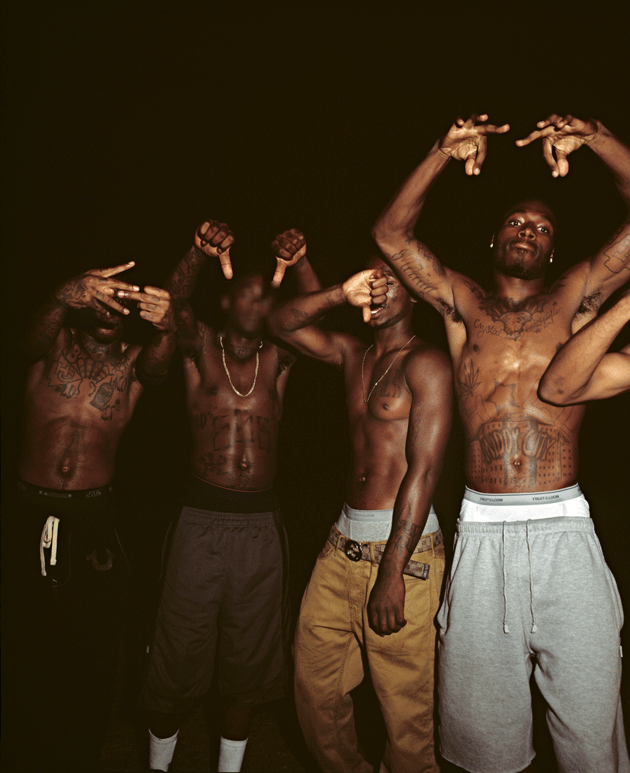by ZADIE SMITH
 “Signs,” by Deana Lawson, from a series of staged photographs that explore the perception of race in American culture. Lawson’s work was on view last month as part of the Whitney Biennial at the Whitney Museum of American Art, in New York City. PHOTO/the artist; Rhona Hoffman Gallery, Chicago; and Sikkema Jenkins & Co., New York City
“Signs,” by Deana Lawson, from a series of staged photographs that explore the perception of race in American culture. Lawson’s work was on view last month as part of the Whitney Biennial at the Whitney Museum of American Art, in New York City. PHOTO/the artist; Rhona Hoffman Gallery, Chicago; and Sikkema Jenkins & Co., New York City
Discussed in this essay:
Get Out, directed by Jordan Peele. Blumhouse Productions, QC Entertainment, and Monkeypaw Productions, 2017. 104 minutes.
Open Casket, by Dana Schutz. 2017 Whitney Biennial, Whitney Museum of American Art, New York. March 17–June 11, 2017.
You are white—
yet a part of me, as I am a part of you.
That’s American.
Sometimes perhaps you don’t want to be a part of me.
Nor do I often want to be a part of you.
But we are, that’s true!
As I learn from you,
I guess you learn from me—
although you’re older—and white—
and somewhat more free.
—Langston Hughes
Early on, as the opening credits roll, a woodland scene. We’re upstate, viewing the forest from a passing car. Trees upon trees, lovely, dark and deep. There are no people to be seen in this wood—but you get the feeling that somebody’s in there somewhere. Now we switch to a different world. Still photographs, taken in the shadow of public housing: the basketball court, the abandoned lot, the street corner. Here black folk hang out on sun-warmed concrete, laughing, crying, living, surviving. The shots of the woods and those of the city both have their natural audience, people for whom such images are familiar and benign. There are those who think of Frostian woods as the pastoral, as America the Beautiful, and others who see summer in the city as, likewise, beautiful and American. One of the marvelous tricks of Jordan Peele’s debut feature, Get Out, is to reverse these constituencies, revealing two separate planets of American fear—separate but not equal. One side can claim a long, distinguished cinematic history: Why should I fear the black man in the city? The second, though not entirely unknown (Deliverance, The Wicker Man), is certainly more obscure: Why should I fear the white man in the woods?
A few years ago I interviewed Peele as he came to the end of a long run on the celebrated Comedy Central sketch show Key and Peele. On that occasion he spoke about comic reversals—“I think reversals end up being the real bread and butter of the show”—and about finding the emotional root of a joke in order to intensify it: “What’s the mythology that is funny just because people know it’s not true?” Get Out is structured around such inversions and reversals, although here “funny” has been replaced, more often than not, with “scary,” and a further question has been posed: Which mythology? Or, more precisely: Whose? Instead of the familiar, terrified white man, robbed at gunpoint by a black man on a city street, we meet a black man walking in the leafy white suburbs, stalked by a white man in a slow-moving vehicle from whose stereo issues perhaps the whitest song in the world: “Run, rabbit, run, rabbit, run run run …”
Get Out flips the script, offering a compendium of black fears about white folk. White women who date black men. Waspy families. Waspy family garden parties. Ukuleles. Crazy younger brothers. Crazy younger brothers who play ukuleles. Sexual psychopaths, hunting, guns, cannibalism, mind control, well-meaning conversations about Obama. The police. Well-meaning conversations about basketball. Spontaneous roughhousing, spontaneous touching of one’s biceps or hair. Lifestyle cults, actual cults. Houses with no other houses anywhere near them. Fondness for woods. The game bingo. Servile household staff, sexual enslavement, nostalgia for slavery—slavery itself. Every one of these reversals “lands”—just like a good joke—simultaneously describing and interpreting the situation at hand, and this, I think, is what accounts for the homogeneity of reactions to Get Out: It is a film that contains its own commentary.
Harper’s for more
